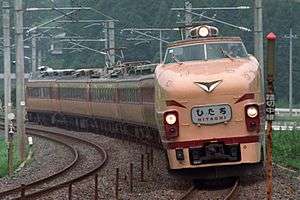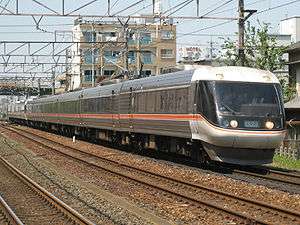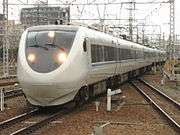381 series
| 381 series | |
|---|---|
|
A 381 series on a Mahoroba service in May 2010 | |
| In service | 1973–Present |
| Manufacturer | Hitachi, Kawasaki Heavy Industries, Kinki Sharyo |
| Replaced | 183 series |
| Refurbishment | 1997–2011 (JR-West) |
| Number built | 277 vehicles |
| Number in service | 136 vehicles (as of 1 April 2015) |
| Number preserved | 2 vehicles |
| Number scrapped | 94 vehicles |
| Formation | 3/4/6/7/9 cars per trainset |
| Operator(s) |
JNR (1973–1987) JR Central (1987–2008) JR-West (1987–Present) |
| Depot(s) | Hineno, Goto, Fukuchiyama |
| Specifications | |
| Car body construction | Aluminium alloy |
| Car length | 21,300 mm (69 ft 11 in) |
| Width | 2,920 mm (9 ft 7 in) |
| Height | 3,383 mm (11 ft 1.2 in) |
| Maximum speed | 120 km/h (75 mph) |
| Electric system(s) | 1,500 V DC |
| Current collection method | Overhead wire |
| Track gauge | 1,067 mm (3 ft 6 in) |
The 381 series (381系 Sanbyaku-hachijūichi-kei) is a tilting DC electric multiple unit (EMU) train type introduced in 1973 by Japanese National Railways (JNR), and currently operated by West Japan Railway Company (JR-West), and formerly also operated by Central Japan Railway Company (JR Central) in Japan.[1]
Fleet
As of 1 April 2015, 136 vehicles were operated by JR-West.[2]
Operations
JR Central
- Shinano (1973–May 2008)
JR-West
- Kuroshio (from October 1978 until 30 October 2015[3])
- Yakumo
- Kounotori (until 31 May 2011,[4] from 1 June 2012[5] until 30 October 2015[6])
- Kinosaki (from 1 June 2012[5] until 30 October 2015[6])
- Hashidate (from 16 March 2013 until 30 October 2015[6])
- Hanwa Liner rapid service (until March 2011)
- Yamatoji Liner rapid service (until March 2011)
Livery variations
-

JNR Livery (JR Central Shinano set), July 2006
-

JR-West Kuroshio refurbished set
-

381 series Super Kuroshio set, 1992
-
381 series Super Kuroshio KuRo 380 refurbished car
-
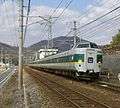
JR-West Yakumo set, July 2007
-

JR-West set in Super Yakumo livery, September 2007
-

JR-West set in Yuttari Yakumo livery, December 2009
History
The 381 series EMU was developed from the experimental 591 series 3-car articulated tilting EMU tested from 1970.[7]
The 381 series entered revenue service from 10 July 1973 on the Shinano limited express between Nagoya and Nagano.[7]
JR-West 381 series trains were removed from Kuroshio, Kounotori, Kinosaki, and Hashidate limited express services in October 2015, with the last services operating on 30 October.[6]
Preserved examples
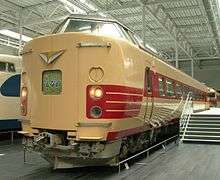
- KuHa 381-1: (built 1973 by Kawasaki Heavy Industries) SCMaglev and Railway Park, Nagoya[8]
- KuRo 381-11: (built 1974 by Kawasaki Heavy Industries) SCMaglev and Railway Park, Nagoya[8]
References
| Wikimedia Commons has media related to 381 series. |
- ↑ JR全車輌ハンドブック2009 [JR Rolling Stock Handbook 2009] (in Japanese). Japan: Neko Publishing. 2009. ISBN 978-4-7770-0836-0.
- ↑ JR電車編成表 2015夏 [JR EMU Formations - Summer 2015] (in Japanese). Japan: Kotsu Shimbunsha. 20 May 2015. p. 406. ISBN 978-4-330-56915-4.
- ↑ くろしお381系引退へ…パンダシートも見納め [Kuroshio 381 series to be withdrawn - Also end of panda seats]. Yomiuri Online (in Japanese). Japan: The Yomiuri Shimbun. 29 October 2015. Retrieved 29 October 2015.
- ↑ "新型車両(287 系)追加投入の詳細" [Details of further introduction of new (287 series) trains] (pdf). JR-West news release (in Japanese). West Japan Railway Company. 28 April 2011. Retrieved 2 May 2011.
- 1 2 "JR西日本 381系福知山車FE編成が営業運転開始" [JR-West: Fukichiyama-based 381 series FE sets enter service]. Tetsudō Daiya Jōhō Magazine. Japan: Kōtsū Shimbun. 41 (340): 75. August 2012.
- 1 2 3 4 381系が関西地区の定期運用から離脱 [381 series removed from scheduled Kansai area services]. Japan Railfan Magazine Online (in Japanese). Japan: Koyusha Co., Ltd. 31 October 2015. Retrieved 1 November 2015.
- 1 2 プロトタイプの世界 - Prototype World. Japan: Kōtsū Shimbunsha. December 2005. pp. 12–19. OCLC 170056962.
- 1 2 "「リニア・鉄道館」ファーストガイド" ["SCMaglev and Railway Park" First Guide]. Tetsudō Daiya Jōhō Magazine. Japan: Kōtsū Shimbun. 40 (324): 20–33. April 2011.
.jpg)
